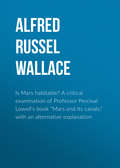
Alfred Russel Wallace
Travels on the Amazon
May not the curious disease, to which they are so subject, be produced by their habit of constantly sleeping naked on the sand, instead of in the comfortable, airy, and cleanly hammock, so universally used by almost every other tribe of Indians in this part of South America?
The Catauixis, though in the immediate neighbourhood of the last, are very different. They have permanent houses, cultivate mandiocca, sleep in hammocks, and are clean-skinned. They go naked like the last, but do not bore holes in their nose and lips; they wear a ring of twisted hair on their arms and legs. They use bows, arrows, and gravatánas, and make the ervadúra, or ururí poison. Their canoes are made of the bark of a tree, taken off entire. They eat principally forest game, tapirs, monkeys, and large birds; they are, however, cannibals, killing and eating any Indians of other tribes they can procure, and they preserve the meat, smoked and dried. Senhor Domingos, a Portuguese trader up the river Purús, informed me that he once met a party of them, who felt his belly and ribs, as a butcher would handle a sheep, and talked much to each other, apparently intimating that he was fat, and would be excellent eating.
PLATE VIII.

FIGURES ON THE GRANITE ROCKS OF THE RIVER UAUPÉS.
PLATE IX.

FIGURES ON THE GRANITE ROCKS OF THE RIVER UAUPÉS.
Of the Jamamarís we have no authentic information, but that they much resemble the last in their manners and customs, and in their appearance.
The Jubirís are equally unknown; they, however, most resemble the Purupurús in their habits and mode of life, and, like them, have their bodies spotted and mottled, though not to such a great extent.
In the country between the Tapajóz and the Madeira, among the labyrinth of lakes and channels of the great island of the Tupinambarános, reside the Mundrucús, the most warlike Indians of the Amazons. These are, I believe, the only perfectly tattooed nation in South America: the markings are extended all over the body; they are produced by pricking with the spines of the pupunha palm, and rubbing in the soot from burning pitch to produce the indelible bluish tinge.
They make their houses with mud walls, in regular villages. In each village they have a large building which serves as a kind of barrack, or fortress, where all the men sleep at night, armed with their bows and arrows, ready in case of alarm: this house is surrounded within with dried heads of their enemies: these heads they smoke and dry, so as to preserve all the features and the hair most perfectly. They make war every year with an adjoining tribe, the Parentintins, taking the women and children for slaves, and preserving the heads of the men. They make good canoes and hammocks. They live principally on forest-game, and are very agricultural, making quantities of farinha and growing many fruits. The men have each one wife, and each village its chief. Cravo or wild nutmegs, and farinha, are the principal articles of their trade; and they receive in exchange cotton cloth, iron goods, salt, beads, etc.
In the Rio Branco are numerous tribes, and some of them are said to practise circumcision.
Others, near the sources of the Tapajóz, make the girls undergo the same cruel initiation as has been already described as common among the Uaupés and Isánna Indians.
On the north banks of the Rio Negro are many uncivilised tribes, very little known.
On the south banks, the Manaós were formerly a very numerous nation. It appears to have been from these tribes that the various accounts of imaginary wealth prevalent soon after the discovery of America were derived; the whole of them are now civilised, and their blood mingles with that of some of the best families in the Province of Pará; their language is said still to exist, and to be spoken by many old persons, but I was never fortunate enough to meet with any one understanding it.
One of the singular facts connected with these Indians of the Amazon valley, is the resemblance which exists between some of their customs, and those of nations most remote from them. The gravatána, or blow-pipe, reappears in the sumpitan of Borneo; the great houses of the Uaupés closely resemble those of the Dyaks of the same country; while many small baskets and bamboo-boxes, from Borneo and New Guinea, are so similar in their form and construction to those of the Amazon, that they would be supposed to belong to adjoining tribes. Then again the Mundrucús, like the Dyaks, take the heads of their enemies, smoke-dry them with equal care, preserving the skin and hair entire, and hang them up around their houses. In Australia the throwing-stick is used; and, on a remote branch of the Amazon, we see a tribe of Indians differing from all around them, in substituting for the bow a weapon only found in such a remote portion of the earth, among a people differing from them in almost every physical character.
It will be necessary to obtain much more information on this subject, before we can venture to decide whether such similarities show any remote connection between these nations, or are mere accidental coincidences, produced by the same wants, acting upon people subject to the same conditions of climate and in an equally low state of civilisation; and it offers additional matter for the wide-spreading speculations of the ethnographer.
The main feature in the personal character of the Indians of this part of South America, is a degree of diffidence, bashfulness, or coldness, which affects all their actions. It is this that produces their quiet deliberation, their circuitous way of introducing a subject they have come to speak about, talking half an hour on different topics before mentioning it: owing to this feeling, they will run away if displeased rather than complain, and will never refuse to undertake what is asked them, even when they are unable or do not intend to perform it.
It is the same peculiarity which causes the men never to exhibit any feeling on meeting after a separation; though they have, and show, a great affection for their children, whom they never part with; nor can they be induced to do so, even for a short time. They scarcely ever quarrel among themselves, work hard, and submit willingly to authority. They are ingenious and skilful workmen, and readily adopt any customs of civilised life that may be introduced among them; and they seem capable of being formed, by education and good government, into a peaceable and civilised community.
This change, however, will, perhaps, never take place: they are exposed to the influence of the refuse of Brazilian society, and will probably, before many years, be reduced to the condition of the other half-civilised Indians of the country, who seem to have lost the good qualities of savage life, and gained only the vices of civilisation.
APPENDIX
ON AMAZONIAN PICTURE-WRITINGS
As connected with the languages of these people, we may mention the curious figures on the rocks commonly known as picture-writings, which are found all over the Amazon district.
The first I saw was on the serras of Montealegre, as described in my Journal (p. 104). These differed from all I have since seen, in being painted or rubbed in with a red colour, and not cut or scratched as in most of the others I met with. They were high up on the mountain, at a considerable distance from any river.
The next I fell in with were on the banks of the Amazon, on rocks covered at high water just below the little village of Serpa. These figures are principally of the human face, and are roughly cut into the hard rock, blackened by the deposit which takes place in the waters of the Amazon, as in those of the Orinooko.
Again, at the mouth of the Rio Branco, on a little rocky island in the river, are numerous figures of men and animals of a large size scraped into the hard granitic rock. Near St. Isabel, S. Jozé, and Castanheiro, there are more of these figures, and I found others on the Upper Rio Negro in Venezuela. I took careful drawings of all of them,—which are unfortunately lost.
In the river Uaupés also these figures are very numerous, and of these I preserved my sketches. They contain rude representations of domestic utensils, canoes, animals, and human figures, as well as circles, squares, and other regular forms. They are all scraped on the excessively hard granitic rock. Some are entirely above and others below high-water mark, and many are quite covered with a growth of lichens, through which, however, they are still plainly visible. (Plates VIII. and IX.) Whether they had any signification to those who executed them, or were merely the first attempts of a rude art guided only by fancy, it is impossible now to say. It is, however, beyond a doubt that they are of some antiquity, and are never executed by the present race of Indians. Even among the most uncivilised tribes, where these figures are found, they have no idea whatever of their origin; and if asked, will say they do not know, or that they suppose the spirits did them. Many of the Portuguese and Brazilian traders will insist upon it that they are natural productions, or, to use their own expression, that "God made them;" and on any objection being made they triumphantly ask, "And could not God make them?" which of course settles the point. Most of them in fact are quite unable to see any difference between these figures and the natural marks and veins that frequently occur in the rocks.







